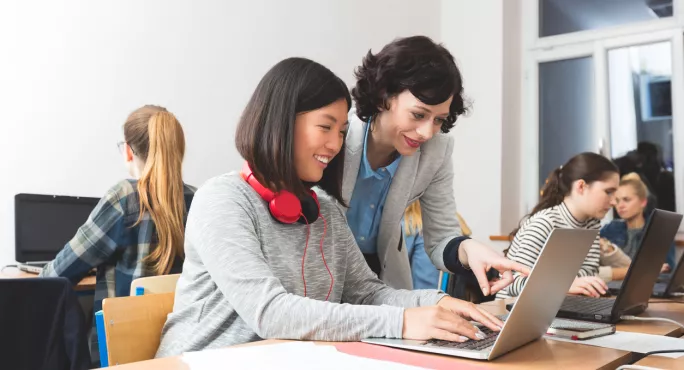- Home
- What is the IB middle years programme?
What is the IB middle years programme?

The International Baccalaureate middle years programme (IBMYP) is fairly new. It was first established as an initiative of the International Schools Association before being introduced as part of the IB continuum in 1994.
After a review, it was relaunched in 2014. Now there are more than 1,300 schools teaching the MYP in around 100 countries.
The curriculum is designed for students aged 11 to 16 and bridges the gap between the IB primary years and diploma programmes. As with all IB programmes, the MYP aims to develop students who are confident in leading their own learning and can apply that learning to an authentic global context.
All IB programmes centre on the learner profile, which outlines that IB pupils are inquirers, thinkers, communicators and risk-takers, who are principled, open-minded, caring, balanced and reflective.
Throughout the MYP, students are asked to identify the ways that they embody those traits.
Students are the centre of learning and, through the MYP, are encouraged to focus on developing self-efficacy on global and civic issues.
MYP subject groups
They do all of this through eight subject groups: language A (English or mother tongue), language B (a learned language or English as an additional language), mathematics, sciences, humanities (history, geography, economics, global issues), technology (information, design), the arts (visual art, music and drama) and physical education.
Language acquisition is a compulsory component of the MYP in every year of the programme. This is part of the IB’s dedication to creating a curriculum that develops students to thrive in a global workplace.
Approaches to learning
At the heart of the MYP are the approaches to learning (ATL), which run through all of these subjects. They help students to think about their learning in the right context, to make connections between their learning across their classes and in relation to the real world.
ATL focuses on the idea of “learning how to learn” that is key to all IB programmes.
Incorporating the ATL into lessons helps students to take control of their own learning, examine how they learn best, and develop good study habits and critical thinking.
ATL skills are broken down into five skill categories and 10 skill clusters.
- Communication skills.
- Social: collaboration skills.
- Self-management: organisation, affective and reflection skills.
- Research: information literacy and media literacy skills.
- Thinking: critical-thinking, creative and transfer skills.
Each MYP unit identifies which of these ATL skills the students will be focusing on. Through the MYP, students will develop an understanding of how they learn, how they learn best and how effective their learning is.
The ATL helps students to:
- Become lifelong learners.
- Learn by doing and experience.
- Think critically.
- Explore global challenges.
- Learn for understanding (not just memorisation).
- Train themselves to organise work, meet deadlines, concentrate, bounce back, persist, think positively.
- See that subjects aren’t taught in isolation.
- Empower themselves to develop their talents.
- Prepare themselves for future education.
- Be internationally minded.
Assessment in the MYP
The IBMYP has received criticism for not including any externally moderated exams. In an attempt to avoid students focusing too much on their final grades, the IB prefer to focus on students learning to learn rather than studying facts in order to pass exams.
However, in a move towards recognised external grading, from 2016, the programme introduced mandatory external moderation of students’ personal projects. It also now gives schools the chance to offer externally marked eAssesments.
MYP optional eAssessment consists of ePortfolios and on-screen examinations.
Personal project
In Year 5 of the MYP, students complete the personal project, an externally assessed project. Schools register all MYP Year 5 students for external moderation of the personal project.
The projects encourage students to engage with service learning and prepare them for the IB diploma programme and its core components, known as CAS (creativity, activity, service).
eAssessment
Students also have the option to take the MYP eAssessment, which consists of externally evaluated coursework ePortfolios and onscreen examinations, similar to those taken at GCSE.
On-screen examination subjects are mathematics, language and literature, sciences, individuals and societies. Students complete the examinations on a computer and engage with the exam through interactive on-screen tools, such as videos and the ability to plot graphs.
The ePortfolios can be created in arts, design, PHSE (personal, social, health and economic education) and language acquisition.
Both allow MYP students to express their knowledge in ways that are natural and comfortable to them, and give schools the flexibility to choose to engage in the MYP eAssessment process if it suits their context.
Find more on the IB, including resources, discussion and news.
Register with Tes and you can read two free articles every month plus you'll have access to our range of award-winning newsletters.
Keep reading with our special offer!
You’ve reached your limit of free articles this month.
- Unlimited access to all Tes magazine content
- Save your favourite articles and gift them to your colleagues
- Exclusive subscriber-only stories
- Over 200,000 archived articles
- Unlimited access to all Tes magazine content
- Save your favourite articles and gift them to your colleagues
- Exclusive subscriber-only stories
- Over 200,000 archived articles



